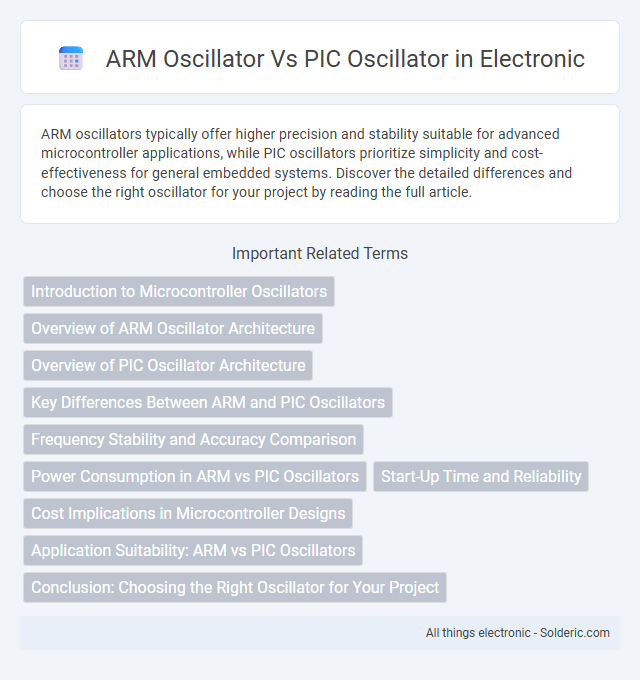ARM oscillators typically offer higher precision and stability suitable for advanced microcontroller applications, while PIC oscillators prioritize simplicity and cost-effectiveness for general embedded systems. Discover the detailed differences and choose the right oscillator for your project by reading the full article.
Comparison Table
| Feature | ARM Oscillator | PIC Oscillator |
|---|---|---|
| Architecture | Advanced RISC Machine (ARM) core | Peripheral Interface Controller (PIC) microcontroller |
| Clock Source | Internal RC, crystal, external clock, PLL options | Internal RC, crystal, external clock |
| Frequency Range | Up to several hundred MHz (varies by model) | Up to 64 MHz (depends on PIC series) |
| Power Consumption | Optimized for low power with dynamic scaling | Low power, suitable for embedded applications |
| Stability | High stability with PLL and crystal options | Stable with crystal and RC options, less advanced PLL |
| Flexibility | Wide range of configurations and clock sources | Basic clock configurations, limited PLL options |
| Common Use Cases | High-performance embedded systems, IoT, mobile devices | Simple embedded systems, cost-sensitive applications |
Introduction to Microcontroller Oscillators
Microcontroller oscillators, such as those in ARM and PIC architectures, serve as critical clock sources that regulate timing and synchronization for internal operations. ARM oscillators typically offer higher precision and flexibility with multiple clock source options, including crystal and RC oscillators, supporting advanced applications requiring stable clocking. PIC oscillators provide integrated simplicity with built-in RC oscillators and PLL options, ideal for cost-effective designs where Your project demands reliable and efficient timing solutions.
Overview of ARM Oscillator Architecture
ARM oscillator architecture integrates high-precision crystal oscillators and configurable RC oscillators, enabling stable clock sources essential for microcontroller performance. It supports multiple clock domains with low power consumption modes and dynamic frequency scaling, optimizing system efficiency. This flexible oscillator design enhances timing accuracy and system reliability across diverse ARM-based applications.
Overview of PIC Oscillator Architecture
PIC oscillator architecture integrates internal RC oscillators, crystal oscillators, and external clock sources to provide versatile and stable clock signals for microcontroller operation. The design supports multiple frequency ranges, including low-power modes with precise timing control, optimizing energy efficiency in embedded systems. Crystal oscillators in PIC devices ensure high-frequency stability compared to internal RC oscillators, which offer faster startup times but lower accuracy.
Key Differences Between ARM and PIC Oscillators
ARM oscillators typically support a wider frequency range and offer higher precision frequency stability compared to PIC oscillators, which are optimized for low power consumption in simpler embedded applications. ARM microcontrollers often integrate phase-locked loop (PLL) circuits for frequency multiplication, enabling faster clock speeds, whereas PIC oscillators rely on basic crystal or RC oscillators suited for moderate speed requirements. Your choice between ARM and PIC oscillators should consider the application's need for speed, power efficiency, and clock accuracy.
Frequency Stability and Accuracy Comparison
ARM oscillators typically offer higher frequency stability and accuracy due to advanced integrated temperature-compensated crystal oscillators (TCXOs) and phase-locked loop (PLL) technologies. PIC microcontroller oscillators often rely on internal RC oscillators with lower precision and are more susceptible to temperature and voltage variations, leading to reduced frequency stability. Consequently, ARM-based systems are preferred for applications demanding tight clock tolerance and minimal frequency drift over varying environmental conditions.
Power Consumption in ARM vs PIC Oscillators
ARM oscillators typically exhibit lower power consumption compared to PIC oscillators, making them ideal for energy-efficient applications and battery-powered devices. ARM architectures often incorporate advanced power-saving techniques such as dynamic frequency scaling and sleep modes that reduce energy usage during idle periods. Your choice of oscillator can significantly impact overall device efficiency, with ARM oscillators providing superior power management capabilities for prolonged operation.
Start-Up Time and Reliability
ARM oscillators typically demonstrate faster start-up times due to advanced crystal stabilization circuits and integrated frequency trimming, enhancing initial signal acquisition. PIC oscillators offer reliable performance with simpler circuitry, but their start-up time can be slower, especially in low-power configurations. Reliability in ARM oscillators benefits from built-in noise reduction and temperature compensation, whereas PIC oscillators emphasize robustness in harsh environments through hardware simplicity.
Cost Implications in Microcontroller Designs
ARM oscillators generally offer higher performance at a premium cost compared to PIC oscillators, which are known for their cost-effectiveness in budget-sensitive microcontroller designs. The choice between ARM and PIC oscillators directly impacts the overall project cost, with PIC oscillators providing a more economical solution for applications requiring moderate precision and stability. Your design budget and performance requirements must be balanced to select the optimal oscillator, as ARM oscillators typically drive up expenses but deliver superior accuracy and feature sets.
Application Suitability: ARM vs PIC Oscillators
ARM oscillators excel in high-performance applications requiring precision timing and low power consumption, such as smartphones and embedded systems with complex processing needs. PIC oscillators are well-suited for simpler, cost-sensitive applications like basic microcontroller projects and industrial controls, where moderate timing accuracy suffices. The choice hinges on balancing processing requirements, power efficiency, and cost constraints specific to the target application.
Conclusion: Choosing the Right Oscillator for Your Project
Selecting the right oscillator depends on your project's performance requirements and power constraints. ARM oscillators typically offer higher precision and lower jitter, making them ideal for applications demanding accuracy and stability. PIC oscillators are often more cost-effective and simpler to implement, suitable for less timing-critical projects with budget limitations.
ARM oscillator vs PIC oscillator Infographic

 solderic.com
solderic.com